Antioxidants, Part 1 ~ 4 Awesome Antioxidants
Antioxidants, Part 1 ~ 4 Awesome Antioxidants
In the first of a three-part series on antioxidants, we will look at vitamins and minerals which have antioxidant roles in the body. But first, why antioxidants are awesome.
What Is a Free Radical?
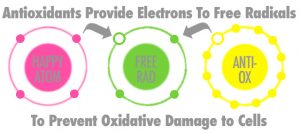
The process of living (breathing, metabolism, energy production) creates unstable molecules — free radicals. Free radicals are intermediates of oxygen, including superoxide and hydroxyl radicals. Exercise, for instance, increases oxygen reactions, increasing the number of free radicals. There are environmental sources of free radicals as well. Sunlight, atmospheric ozone, pollution, tobacco smoke, and pesticides/herbicides (consumed on our food or ingested from the air) all create oxidative damage. These free radicals have unpaired electrons, whereas stable molecules such as amino acids and glucose are held together by paired electrons. A molecule with an unpaired electron looks to steal an electron from another molecule, thus creating a destructive cycle. Insidiously, after the rogue molecule steals a neighbor’s electron it does not regain its original form and function but is still unchecked in spreading havoc.
These reactive molecules can cause cellular breakdown in a variety of ways:
- They disrupt, break off or puncture a stable cell’s membrane;
- They make membranes brittle by fusing lipids and proteins;
- They mutate and destroy genetic material;
- They cause damage to immune cells.
Awesome Antioxidants to the Rescue!
An antioxidant is a substance which neutralizes the free radical and fights the oxidation it caused. It does this by supplying the missing electron or removing an extra one to stabilize the rogue molecule. The antioxidant is now technically made a free radical itself, but its structure makes it many times less destructive than the original free radical. Awesome!
One of the most accepted theories of the process of aging in the human body is that of the free-radical theory. In simple terms, wear and tear on cells (oxidation) caused by damaging free-radical molecules is a major contributor to aging. With this theory comes the understanding that antioxidant nutrients help to lessen the damage and thus slow or prevent some of the conditions and diseases which come with aging. Beta-carotene in combination with vitamins C and E, for example, has been shown to reduce the risk of many types of cancer, cataracts, macular degeneration, heart disease, and respiratory ailments such as asthma.
Vitamins as Antioxidant Nutrients
The antioxidant nutrients found in food are absorbed during digestion and then travel through the bloodstream to reach cells and organs. The primary antioxidant nutrients are beta-carotene (pro-vitamin A), vitamin C, vitamin E, and the mineral selenium. These are all distinct in chemical structure and nature.
1) Beta-Carotene
Beta-carotene is a fat-soluble nutrient. Whether taken as a supplement or when consuming foods rich in this, it should be ingested with other fatty foods to enhance absorption. Interestingly, in food the beta-carotene is bound in tight complexes, making absorption difficult, and supplements are better absorbed. This nutrient functions in several ways, both preventing formation of free radicals and disabling existing ones by quenching a highly reactive oxygen called singlet oxygen. It quenches UV radiation free-radicals in the eye as well as in the skin, it protects epithelial tissue in the lungs and may ward off cognitive decline.
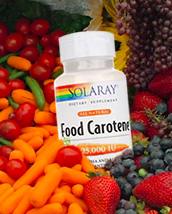
In the liver beta-carotene is converted to vitamin A, an essential nutrient. The advantage of dietary beta carotene is that the body only converts as much as it needs. Excess vitamin A is toxic and toxic vitamin A levels can occur if you consume too many supplements. For this reason many multivitamins have a reduced dosage of vitamin A, replacing it with beta-carotene.
Food sources include anything with orange and red pigments generally: apricots, carrots, squash, pumpkin, as well as green vegetables like spinach and endive. Solaray’s Food Carotene provides multiple carotenoids in addition to 25,000 international units of beta-carotene from a natural algae source.
2) Vitamin C
Vitamin C is a water-soluble nutrient, thus working primarily in areas of the body like plasma, lung and eye fluid, and interstitial (between cells) fluid. Functions include white blood cell activity and other immune system biochemistry. Collagen formation requires vitamin C. When under physical stress such as illness or injury or extreme temperatures, levels of vitamin C plummet and need to be replenished. The adrenal glands contain large amounts of vitamin C. It is regenerated by vitamin E, and in turn can regenerate vitamin E.
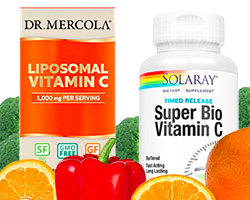
Food sources include fresh fruits and vegetables: bell peppers, citrus, broccoli, cauliflower, okra, berries. Recently supplements have been introduced which bind the molecule to lecithin or another fat to improve absorption and increase activity in the body. Dr Mercola’s Liposomal Vitamin C for example, increases absorption with a phospholipid from sunflower lecithin.
Also look for products which include bioflavonoids (rutin, quercetin) which increase absorption and provide their own antioxidant, anti-inflammatory benefits. Solaray’s Super Bio C is an excellent combination of a multiple-sourced vitamin C (acerola, rose hips) with a 700 mg blend of bioflavonoids. Plus, this buffered vitamin C is two-stage time release, so it’s fast acting and long lasting.
3) Vitamin E
Vitamin E is a fat-soluble superstar, protecting the lipids of every cell’s membrane. These membranes are susceptible to rancidity, just like vegetable oils. It also scavenges free radicals in the blood. Increased consumption of heart-healthy mono- and polyunsaturated fats is a trend these days, with good reason. However, these healthy fats will also increase one’s need for vitamin E to protect body tissues from the oxidation which will eventually occur. The more unsaturated a fat is the more susceptible to rancidity and oxidation it is. Flax oil, fish oil and other omega-3 fats are examples here. One study found that the addition of cod liver oil to the diet increased the vitamin E requirement nearly 100-fold.
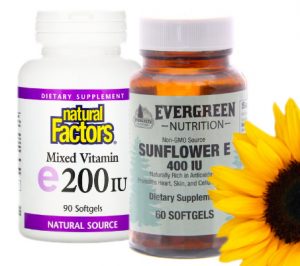
In supplements, always look for the natural-source vitamin E (d-alpha tocopherol) rather than the synthetic dl-alpha form. Evergreen Nutrition carries only the natural, well-absorbed d-alpha form of this crucial vitamin.
Food sources include nuts, seeds, wheat germ, soybeans and sweet potatoes. Natural Factors offers their Mixed Vitamin E 400 IU softgels, a blend of the family of tocopherols offering more activity than simply d-alpha. Also available is Evergreen’s own Sunflower Vitamin E, made from non-GMO sunflowers, not derived from soy as are most vitamin E products.
4) Selenium
Selenium is an essential trace mineral. What makes this mineral special is that it is not only a potent antioxidant by itself, it also acts in concert with vitamin E against some of the more nefarious free radicals. In addition, it forms part of the powerful antioxidant enzyme glutathione peroxidase that neutralizes harmful hydrogen peroxide molecules both intra- and inter-cellularly. It can prevent oxidation of polyunsaturated fatty acids like its cohort vitamin E, and maintains elasticity of body tissues. It is crucial for thyroid health and a deficiency can lead to thyroid problems. It is also involved in reproductive health.
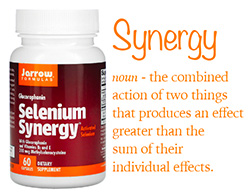
Food sources of selenium are brewers and nutritional yeasts, nuts (especially Brazil nuts), organ meats, seafood, whole grains and tofu. Supplements range from 50-200 mcg. Look for the selenomethionine or methylselenocysteine forms, such as Jarrow’s Selenium Synergy which also includes vitamin E.
All For One & One For All
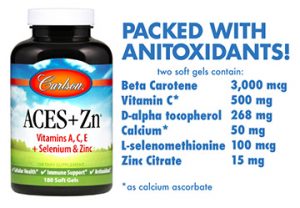
Carlson’s ACES + Zn offers all four of the above-mentioned antioxidants – plus one more! As the name states, it also includes the mineral zinc which not only exhibits antioxidant activity but has anti-inflammatory and immune benefits, too.
Be sure to check out Part 2 of this series in which we will look at endogenous (body-made) antioxidants.
Back to Blog